KAMAKURA
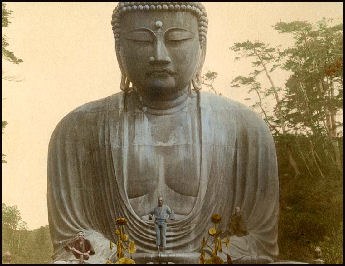
Great Buddha of Kamakura Kamakura (45 minutes south of Tokyo by train) is a small historically-rich coastal town. Flanked by wooded mountains on three sides and Sagami Bay and the Pacific Ocean on the other, the Kamakura area is home to 120 temples and 41 shrines set in a semi-circle of protective hills, a bathing resort, picturesque Enoshima Island, a rich residential town for commuters and a sacred spring where visitors cleanse coins for good luck.. Kamakura also attracts surfers with its beaches. The Japanese government has applied for Kamakura to be named a UNESCO World Heritage site.
Kamakura was the administrative and military center of Japan from the 12th to 14th centuries. The town retains a great deal of the charm of old Japan. It is also the home of the Great Buddha, considered one of the most beautiful statue in the world. Famous for its autumn foliage and spring flowers. Kamakura has a population of 175,000 people. Like Nikko, it is a popular day trip and overnight destination that is often largely empty during the week but becomes crowded on the weekend with tourists, who come to see sights, hike and swim. Some people do a mini pilgrimage to seven shrines, each associated with one of the seven gods of good fortune.
Temples, Shrines and other structures of Ancient Kamakura were nominated to be a UNESCO World Heritage site in 1992. According to a report submitted to UNESCO: “Kamakura was constructed by the samurai (warrior class) to be the seat of their political power. It is surrounded by hills to the north, east and west, and faces the ocean to the south. For this reason, it is ideally protected. The samurai government controlled all of Japan from here for over 150 years, and Kamakura became the center of politics, economy and culture. The samurai government of Japan continued from 1192 to 1868, during which period the cities of Kamakura and Edo were constructed to serve as places of administration. However, Edo later changed into the modern city of Tokyo, so that the only remaining place where one can find a grouping of cultural properties reminiscent of samurai culture is the area around Kamakura. [Source: Agency for Cultural Affairs-Government of Japan]
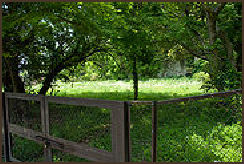
mass suicide site “Today one may see in Kamakura the Tsurugaoka Hachiman-gu (Tsurugaoka Hachiman Shrine), which was at the center of the city plan, and Wakamiya Oji, a large avenue that stretches from the front of the shrine toward the sea. There are a number of temples and temple sites like Kenchoji, Enkakuji, Kotoku-in and Yofukuji, built on the surrounding hillsides, as well as sites of houses belonging to the samurai in power at the time. Also in the surrounding hills are steep pathways, known as the Kamakura Nakakuchi, which served as routes to the outside. Along the ocean front there is Wagae-jima, a port site.”
Tourist Office: The main tourist office (☎ 467-22-3350) is just outside Kamakura Station. Websites: Kamakura City site city.kamakura.kanagawa.jp ; Kamakura Today kamakuratoday.com ; Wikipedia Wikipedia ; Map: city.kamakura.kanagawa.jp/kamakura-kankou/en/plan/course Ryokan and Minshuku Japanese Guest Houses Japanese Guest Houses Budget Accommodation: Japan Youth Hostels Japan Youth Hostels Check Lonely Planet books Getting There: Kamakura is about 45 minutes by train from Tokyo. Lonely Planet Lonely Planet
History of Kamakura
Kamakura was the capital of Japan from in 1185 to 1333 (the Kamakura Period) and has colorful history filled with bloody battles, assassinations, fires and one of the largest mass suicides in history. The site for the town — with the sea to the south and hills on the other sides — was chosen because it was easy to defend.
The Kamakura Period began when the Minamoto clan defeated the Taira clan at the Battle of Dannoura (Shimonoseki) in 1185. Some mark beginning of the period when Yorimoto Minamoto became Japan's first shogun in 1192.
The Kamakura Period was an era in which “bushido” (the way of the samurai) was conceived and developed and the Imperial family was kept out of sight in Kyoto while shoguns ruled through puppet emperors. With the demise of the Chinese-style bureaucratic state a feudal system was conceived that took its place.

The Yorimoto shogunate considered the Imperial family's pursuit of the arts to be wasteful and decadent. They encouraged austerity and the pursuit of the martial arts and used there strength to bring landlords under their control and restore control over Japan.
The Kamakura period came to end in 1333 when thousands of warriors and civilians were killed in when a Imperial forced led by Nitta Yoshisada defeated the shoguns army and set fire to Kamakura. One regent for the shogun and 870 of his me were trapped in Toshoji rather than give up the took their own lives. Some jumped into the fires. Others committed hara-kiri and killed the their comrades. The blood reportedly flowed into the river.
The Kamakura Period was a time when Buddhism spread throughout Japan Many of the main sights are linked with Buddhism, especially the Zen and Pure Land school.
Minamoto Yoritomo took firm control of Japan, established a military government in Kamakura and persuade the Emperor to give him the hereditary title of shogun. He was a member of the Minamoto clan which had seized power from Emperor and the third son of a clan leader who was killed along with any family members and allies after being defeated by the rival Taira clan in 1159.
Minamoto Yoritomo spent his youth in a Buddhist temple. When he was old enough he began gathering allies an set up his base in Kamakura, which was fare for the government seat in Kyoto and close to many of his allies. Minamoto claimed Japan after defeating the Taira clan in a series of battles.
Yorimoto established the first hereditary shogunate near present-day Tokyo in city Kamakura while the emperor remained in isolation in Kyoto. Yorimoto purged members of his own family. When he died after falling from a horse, power fell into the hands of family of Minamoto's wife, the Hojo clan, who wiped out of the potential successors from Yorimoto's family. The Hojo clan ruled for more than a century but was weakened by the cost of defending Japan against the attack by Kublai Khan.
Kamakura Period (1185-1333)
The Kamakura Period (1185-1333) began when the Minamoto clan defeated the Taira clan at the Battle of Dannoura (Shimonoseki) in 1185. Some mark beginning of the period when Yorimoto Minamoto became Japan’s first shogun in 1192. The Kamakura Period was an era in which bushido (the way of the samurai) was conceived and developed and the Imperial family was kept out of sight in Kyoto while shoguns ruled through puppet emperors. With the demise of the Chinese-style bureaucratic state a feudal system was conceived that took its place.
The Yorimoto shogunate considered the pursuit of the arts by the Imperial family and Heian Period nobility to be wasteful and decadent. It encouraged austerity and the pursuit of the martial arts and used its strength to bring landlords under their control and restore control over Japan. According to the Metropolitan Museum of Art: “The Kamakura period was marked by a gradual shift in power from the nobility to landowning military men in the provinces. This era was a time of dramatic transformation in the politics, society, and culture of Japan. The bakufu, or government by warrior chieftains (shogun) or their regents, controlled the country from their base in Kamakura, near modern Tokyo. Because the emperor remained the titular head of state in his capital in Kyoto, a binary system of government, whereby emperors reigned but shoguns ruled, was established and endured for the next seven centuries. [Source: Metropolitan Museum of Art, Department of Asian Art. "Kamakura and Nanbokucho Periods (1185–1392)". Heilbrunn Timeline of Art History, 2000, metmuseum.org \^/]
The Kamakura period marks the transition to the Japanese "medieval" era, a nearly 700-year period in which the emperor, the court, and the traditional central government were left intact but were largely relegated to ceremonial functions. Civil, military, and judicial matters were controlled by the bushi class, the most powerful of whom was the de facto national ruler. The term feudalism is generally used to describe this period, being accepted by scholars as applicable to medieval Japan as well as to medieval Europe. Both had land-based economies, vestiges of a previously centralized state, and a concentration of advanced military technologies in the hands of a specialized fighting class. Lords required the loyal services of vassals, who were rewarded with fiefs of their own. The fief holders exercised local military rule and public power related to the holding of land. This period in Japan differed from the old shoen system in its pervasive military emphasis. [Source: Library of Congress *]
See Separate Article KAMAKURA PERIOD (1185-1333) factsanddetails.com ; BUDDHISM AND CULTURE IN THE KAMAKURA PERIOD factsanddetails.com
Temples and Shrines at Kamakura

Temples and Shrines at Kamakura include the Egara Ten-jin Shrine, Sugimoto-dera Temple, Hokoku-ji Temple, known as the bamboo temple because it is surrounded by dense groves of bamboo, Zuisen-ji Temple, a Zen temples founded in 1327 with lovely, austere gardens, and about 80 others. One of the advantages of these is that they are less crowded than the main temples and shrines
Engakuji Temple (near Kita-Kamakura Station) is the most celebrated Rinzai Zen temple in Kamakura. Founded in 1282 as a place to pray for soldiers who died in the Kublai Khan invasion, it is composed of buildings arranged Zen-style in a straight line and meditation areas shaded with old Japanese cedars.
The oldest structure, the Samon Gate, dates back to 1780. The Hall of the Holy Relics of Buddha features a gracefully curved shingled roof. On a hilltop nearby is the most celebrated bell in Kamakura. The bell, cast in 1301, is the largest bell in Kamakura.
Engakuji Temple contains one of the loveliest gardens in the Tokyo area. Even though it looks like it has been carefully tended for centuries, the garden was created in 1986. Within the 356 square meter space are trees, shrubs, rocks and white gravel that evoke images of a mountain valley, forest and a placid lake with two islands. Chakai tea ceremonies are $20 and matcha ceremonies are $5. Other sight near Engakuji Temple include Tokeu-ji Temple and Jochi-jin Temple, both of which have nice grounds.
Kenchoji Temple (Kamakura) is the most important of the Five Great Zen Temples of Kamakura. Founded in 1253, it is situated in a magnificent grove of Japanese cedars. The original buildings were destroyed by fire in 1415 and structures built after this were badly damaged in feudal civil wars.
The main buildings are the Buddha Hall, the Hall of Law and the Chinese-style Dragon King Hall. Its bell is the second oldest in Kamakura. There is also a piece of a bronze bell cast in 1255. Nearby is Enno-ji Temple, known for collection of statues, which represent the judges of hell.
Hachimangu Shrine
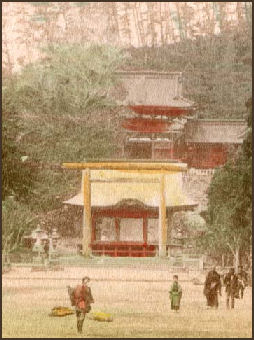
Hachimangu Shrine(about halfway between Kamakura and Kita-Kamakura Station) is a splendid red-veneered temple that contrasts vividly with its natural green surroundings. Believed to be dedicated to a god of war, it was founded in 1192 by the Minamoto clan that established the Japanese capital in Kamakura. The oldest building dates to 1828.
The area between the second and third tori gates is elevated and flanked with wild cherry trees and azaleas. A large ginkgo near the square in front of shrine was the site of famous political assassination in 1219. Nearby is dancing platform formally used by shrine virgins and an arched bridges formal off limits to anyone but the Shogun. A famous centuries-old gingko tree at Tsurugaoko Hachimangu shrine was toppled by high winds in 2010. An effort is being to bring the tree back to life translating the truck, growing shoots from the stump and growing cuttings.
Within the shrine are the National Treasure Museum, Municipal Museum and the Modern Art Museum. Housed in a building that looks like a large log cabin on stilts, the Municipal Museum contains 400 pieces of fine art, sculpture and arts and crafts. The Museum of Modern Art, near Heike Pond, features 250 works of art, including Japanese oil and water-color paintings, wood-block prints and sculptures.
Hundreds of thousands of Japanese visit the shrine to mark New Year's Day. By one estimate 3 million people visit the shrine during the first three days of the New Year and 18 million visit it a year. On January 5th, during a ceremony to drive away evil, people in traditional samurai costumes shoot arrows targets with the Chinese character for evil written on the back. During September mounted archers in traditional costumes shoot at targets in the shrine compound.
Hasedera Temple
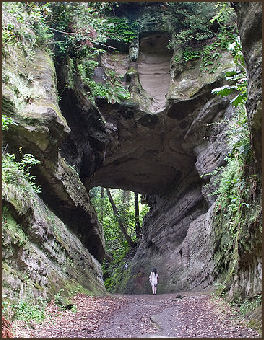
Shakado Pass Hasedera Temple (outskirts of Kannonzan Hill in Kamakura) is a splendid temple perched on a bluff overlooking the Pacific. Dedicated to Kannon, the Japanese Goddess of Mercy, and believed to have been founded in 736, the shrine contained halls for Kannon-do, Amida and Kyakuden. Since ancient times, Hasedera Temple has been known as the 4th station among the 33 holy places in the Kanto area.
The main hall houses the famous eleven-headed gilt statue of Kannon. Thought to have been carved in 721, this 30-foot-high image is one of oldest and tallest wooden image in Japan. According to legend it was carved in Nara and thrown in the sea and washed up in Kamakura 15 years later. In the garden is the gigantic 13th century temple bell and thousands of small Jizo statues. In late November and early December autumn leaves in the lovely gardens around Hasedura Temple are illuminated at night.
As for the legend of the statue, in A.D. 721the pious monk Tokudo Shonin discovered a large camphor tree in the mountain forests near the village of Hase in the Nara region. He realized the trunk of the tree was so large that it provided enough material for carving two statues of the eleven-headed Kannon. The statue he commissioned to be carved from the lower part of the truck was enshrined in Hasedera Temple near Nara; the statue from the upper half (actually the larger of the two) was thrown into the sea with a prayer that it would reappear to save the people. Fifteen years later in 736 on the night of June 18, it washed ashore at Nagai Beach on the Miura Peninsula not far from Kamakura, sending out rays of light as it did. The statue was then brought to Kamakura and a temple was constructed to honor it.
Hasedera is a temple of the Jodo sect of Japanese Buddhism, famous for its eleven-headed statue of Kannon, the goddess of mercy. The 9.18 meter tall, gilded wooden statue is regarded as one of the largest wooden sculpture in Japan and can be viewed in the temple's main building, the Kannon-do Hall. According to legend, it was carved from the same tree as the similarly tall Kannon statue worshiped at the Hasedera Temple in Nara Prefecture.
Adjacent to the main hall is the Kannon Museum, a small museum that requires an additional entrance fee. It exhibits some more of the temple's treasures, including Buddhist statues, a temple bell and a picture scroll. Explanatory signs are in Japanese, and an English pamphlet with basic explanations is available. On the opposite side of the main hall stands the Amida-do Hall with an almost three meter tall, golden statue of Amida Buddha.
Great Buddha of Kamakura
Great Buddha of Kamakura (10 minute walk from Hase Kannon Temple) is Kamakura's most famous sight. Known in Japanese as Daibutsu, it is the second largest bronze Buddha in the world, after the one in Nara. Located on the grounds of the Kotokuin Temple and built in 1252, the Great Buddha is 13.35 meters (43.8 feet) tall and weighs approximately 93 tonnes (103 tons). It lies out in the open but was once housed in a large building like its counterpart in Nara. The original building was washed away by a tsunami in 1465. The length of the statue's face is 2.35 meters (7 feet 9 inches). The eyes are each one meter (3 feet 3 inches) long. The mouth and ears each are 0.82 meters (2 feet 8 inches) and 1.90 meters (6 feet 3 inches) respectively. The distance from knee to knee: is 9.10 meters (29.9 feet). The circumference of the thumb is 0.85 meters (2 feet 9 inches)
The Buddha is a sitting Amithaba Buddha worshiped by the Pure Land sect. The statue is hollow, and visitors can view the interior. A small stairway inside the Buddha enables visitors to reach the small platform near interior of the shoulders. Many people have left graffiti on the inside of the statue. At one time, there were thirty-two bronze lotus petals at the base of the statue, but only four remain, and they are now stored somewhere else. A notice at the entrance to the grounds reads, "Stranger, whosoever thou art and whatsoever be thy creed, when thou enterest this sanctuary remember thou treadest upon ground hallowed by the worship of ages. This is the Temple of Buddha and the gate of the eternal, and should therefore be entered with reverence." [Source: Wikipedia]
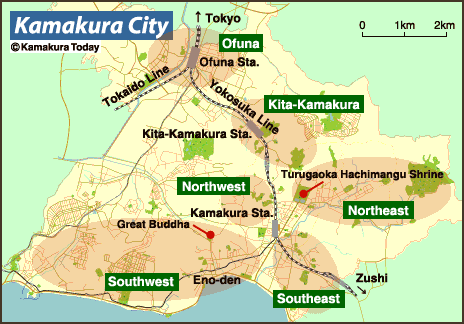
Before the current bronze statue there was a giant wooden Buddha, which was completed in 1243 after ten years of work with funds raised by Lady Inada no Tsubone and the Buddhist priest Joko of Totomi. That wooden statue was damaged by a storm five years later the hall containing it was destroyed, so Joko suggested making a new statue of bronze, and the huge amount of money necessary for this and a new hall was raised for the project. The bronze image was probably cast by Ono Goroemon or Tanji Hisatomo, both leading casters of the time. At one time, the statue was gilded. There are still traces of gold leaf near the statue's ears.
The hall was destroyed by a storm in 1334, was rebuilt, was damaged by yet another storm in 1369, and was rebuilt yet again. The last building housing the statue was washed away in the tsunami resulting from the 1498 Meio Nankaido earthquake. Since then, the Great Buddha has stood in the open air. The 1923 Great Kanto earthquake destroyed the base the statue sits upon, but the base was repaired in 1925. Repairs to the statue were carried out in 1960–61, when the neck was strengthened and measures were taken to protect it from earthquakes. In early 2016, further research, restoration, and preservation work was performed on the statue.
Image Sources: 1) 6) 9) Visualizing Culture, MIT Education 2) 3) 7) Wikipedia 4) 5) Kamakura Today site 8) NASA 10) Okinawa Tourism 11) 12) 13) Tokyo Islands site
Text Sources: JNTO (Japan National Tourist Organization), Japan.org, Japan News, Japan Times, Yomiuri Shimbun, UNESCO, Lonely Planet guides, New York Times, Washington Post, Los Angeles Times, National Geographic, The New Yorker, Bloomberg, Reuters, Associated Press, AFP, Compton's Encyclopedia and various books and other publications.
Updated in July 2020
